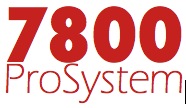Atari 7800
| Atari 7800 | |||
|---|---|---|---|
| Manufacturer |
Atari, Inc. Atari Corporation |
||
| Type | stationary game console | ||
| generation | third generation of consoles | ||
| publication |
|
||
| Main processor | 6502C ("SALLY") clocked at 1.19 - 1.79 MHz | ||
| Graphics processor | MARIA | ||
| Storage media | Modules | ||
| Controller | Digital joysticks Light guns |
||
| Most successful game | Ace of Aces | ||
| predecessor | Atari 5200 | ||
| successor |
Atari Panther (prototype) |
||
The Atari 7800 is a stationary game console of the third console generation from Atari, Inc. and its successor company Atari Corporation .
history
The 7800 should replace the moderately successful Atari 5200 and give Atari a better position in the competition against Intellivision and ColecoVision . With this console Atari tried to remedy the main shortcomings of the 5200: The new console had simple, digital joysticks , was downward compatible with the Atari 2600 and was affordable.
The 7800 was the first Atari console developed by an outside manufacturer (General Computer). The device was initially designed so that a customer could expand the system into a full-fledged home computer: a keyboard was developed, and peripheral devices such as floppy disk drives and printers could be used via a built-in connector . General Computer had also developed a "highscore cartridge", a battery-operated RAM unit for securing scores in games. However, Atari did not produce any of these accessories, so the corresponding connector was later removed.
The console was officially announced on May 21, 1984 and was first released in California in June 1984. A month later, Atari's parent company Warner Communications separated Atari, Inc. and sold the end-user division, now trading as Atari Corporation, to Jack Tramiel , who (like most in the USA) believed that the days of video games were numbered. He stopped the production of Atari's existing systems and invested all funds in the development of the 16-bit Atari ST computer . The 7800 was re-launched in 1986 after the success of the Nintendo Entertainment System proved the video game market was n't dead. At this point, however, NES and Sega Master System had already largely saturated the market, which severely limited the sales success of the 7800. However, Tramiel had no interest in competing with Nintendo and Sega, but wanted to generate additional income for the further development of his home computer series Atari ST with little effort. Therefore, he positioned the Atari 7800 as a cheap alternative to the Japanese market leader.
The technical performance of the 7800 is still controversial today. In terms of architecture, it was just an Atari 2600 with a better CPU and a better graphics chip (MARIA). While the system could display significantly more moving objects (up to 100) than all competing consoles, it was inferior to them in terms of sound. To compensate for this, some games had a POKEY audio chip built into the cartridge (e.g. Ballblazer and Commando ). Developing games for the 7800 was more complex than other current consoles, but many programmers were already familiar with the similar development process for the 2600.
The Atari 7800 suffered from the same software downturn that should be characteristic of all Atari consoles after the video game crash in 1983. Relatively few games were published by Atari, which also often had defects. At the same time, Atari made little effort to attract external developers for the system.
A later revision of the console already contained the game Asteroids in the 7800 variant in ROM.
Source code
When the Atari Corporation was closed in 1996, the annotated source code of the 7800 operating system (with the Asteroids contained therein ) on Atari ST floppy disks, along with Joust , Dig Dug , Robotron: 2084 and eight other games, was recovered from the Atari Museum and later published .
Atari flashback
20 games of the Atari 2600 and 7800 systems were reissued in 2005 with the Atari Flashback console .
Technical specifications
- CPU: 6502C ("SALLY") , clocked with 1.19 - 1.79 MHz
- RAM: 4 kB
- Module size: up to 128 kB
- Graphics chip: MARIA in 7800 mode / TIA in 2600 mode
- Resolutions: 160 × 242, 320 × 242
- Colors (palette): 16 (256)
- Sound chip: TIA
- Sound channels: 2 PSG
- Controller ports: 2
Web links
- Atari 7800 in the Atari Museum
- AtariAge 7800 Games (English)
- neXGam.de Tests and Specials for the Atari 7800 (German)
Individual evidence
- ↑ The top-selling Atari 7800 games. In: vgchartz.com. Retrieved December 8, 2019 .
- ↑ www.neXGam.de: Atari 7800. In: www.nexgam.de. Retrieved December 7, 2016 .
- ^ Steven L. Kent: The Ultimate History of Video Games . Three Rivers Press, New York 2001, ISBN 0-7615-3643-4 , pp. 402-404 .
- ↑ Kevin Parrish: Atari 7800 Source Code Rescued - Atari released the source code for the 7800 console and games. tomsguide.com, July 7, 2009, accessed January 9, 2012 .
- ↑ 7800 Games & Development. atari-museum.com, 2009, accessed on January 9, 2012 : “ These games were rescued from Atari ST format diskettes that were thrown out behind 1196 Borregas when Atari closed up in 1996. The Atari Museum rescued these important treasures and recovered them from the diskettes. "


